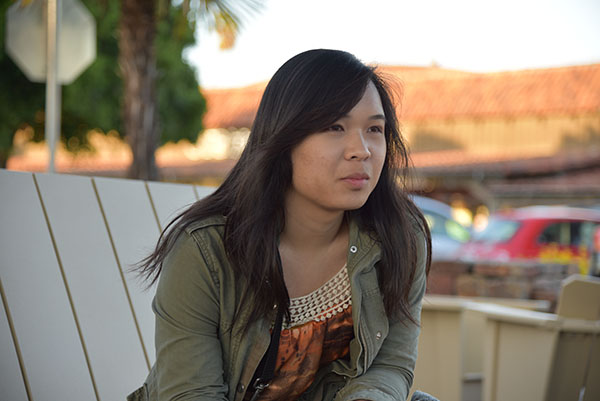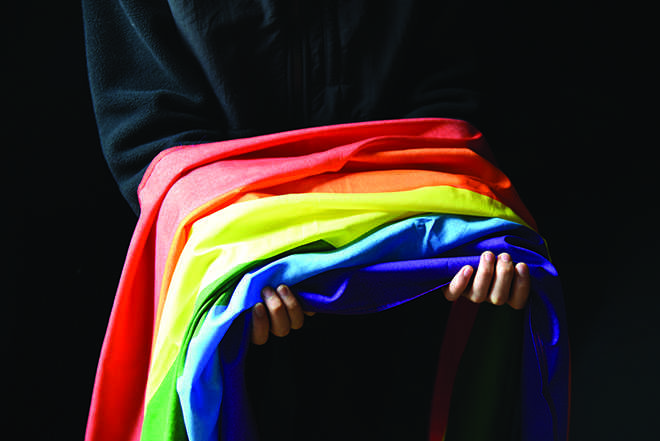Hand-cut cardboard signs taped onto sturdy wire stand on Melissa Michelson’s lawn. A professor of political science at Menlo College, Michelson researches about and advocates for transgender individuals’ rights.
Her efforts to resist President Donald Trump’s actions have translated into her sons’ handmade signs. They read, “We are all immigrants,” “Black Lives Matter,” and “No Ban No Wall.”
The impact of Trump’s actions has traveled across the nation from a federal level to the Palo Alto community, specifically impacting Britney, a transgender Palo Alto Unified School District fourth grader who transitioned from male to female, as well as Thao Nguyen, a transgender Palo Alto High School graduate who transitioned from male to female.
On Feb. 22, 2017, Trump rescinded former president Barack Obama’s bathroom law, which mandated federally funded schools to allow students to use the bathroom of their identified gender. Instead, the Trump administration will allow states to decide whether students should be allowed to use the restrooms of the genders they identify with.
Michelson, who has two sons in the PAUSD, states that forcing transgender people to use the bathrooms of their birth gender makes them victims.
“It’s really disappointing. … Bad things are going to happen where there aren’t any local protections,” she says. “There’s a lot of bullying and violence that goes along with being openly transgender and forcing [transgender people] to not use the right bathroom opens them up to being victims.”
Although California will not be impacted by this law, other states will. Because of this, Verde met with some transgender individuals and their family members. They spoke about their personal stories on their transitions and about the impacts of their child’s transition.
Jillian and Britney
As with many people, the changes for Britney started in her early years. Britney, a PAUSD grade schooler, has looked up to her sister Kerry since she was two. Britney, whose name along with Jillian and Kerry’s has been changed to protect their identities, was young when she began to understand her gender. Because of this, as Britney tells her story, Jillian helps fill in some events that Britney can’t remember well.
Britney was born a male, but identifies as a girl. However, when she was two and still identified as a boy, she would try on her sister’s dresses. Jillian and her husband didn’t think much of it because they thought little kids always experimented with dress up and other games. However, one day Britney said something to her father that Jillian never forgot.
“When she was two, she said, ‘I’m sad, I wish I were a woman,’” Jillian says. “And my husband said, ‘Why do you wish you were a woman?’ And then she said, ‘I wanna wear beautiful clothes and I would like to grow a baby in my belly.’”
Jillian says she and her husband just want Britney to be happy. They paid attention to Britney for a while, and she would dress in girls’ clothes, such as nightgowns and dresses.
“In preschool she still wore basketball shorts and t-shirts from the girls’ department,” Jillian says.
As Britney grew up, she began to vacillate between identifying as a boy or a girl. Over the course of kindergarten and first grade, she would wear both dresses and shorts and she grew her hair long. People weren’t sure of her gender. When kids at school called Britney a boy, she corrected them with the “she” pronoun. In other instances, Britney would corrected her peers with the “he” pronoun.
Once Jillian read a book on transgender individuals, it clicked for her: she realized Britney was transgender.
“This doesn’t make sense. I didn’t feel like a boy, I felt like a girl,” Britney says.
Jillian says Britney is more nonbinary, but Britney says that if she had to choose, she would identify as a girl.
“But if there weren’t, I’d be like, I’m neither, or I’m transgender,” Britney says.
Jillian says the difference for Britney was that the way Britney talked about being a girl was different than how other girls talked about being girls. Her kindergarten teacher observed the difference in identity and talked to Jillian about it.
“Her kindergarten teacher said … Britney in class would talk about … birthing a baby and creating a life, and the teacher said it was different than any of the other girls,” Jillian says.
When Britney was in second grade, she decided to change her pronouns. Jillian emailed Britney’s teacher after winter break, to see if the teacher would be willing to try a pronoun change. The teacher obliged, and during class, Britney introduced herself as a girl. According to Britney, everything went smoothly.
Another issue, however, was Britney’s name. Britney changed her name in the beginning of third grade. Her birth name was still on official documents, such as grades and attendance forms, because Britney’s family hadn’t legally changed her name yet.
The school district was supportive of Britney. Jillian went to the PAUSD District Office and talked to a woman in the welcome center about changing Britney’s name and gender, who was very helpful.
“It was amazing,” Jillian says. “The woman in the welcome center was like ‘I haven’t done that yet, but I know there’s a form, let’s go find it together.’”
Jillian filled out the form, and the woman uploaded the changes to a computer. Ever since then, anything official printed out from her school has Britney’s name instead of her birth name.
Prior to her pronoun change, when she was still in kindergarten, Britney had several issues with which bathroom to use. She dressed like a girl, but still identified as a boy. Still, using the boys’ bathroom made her uncomfortable.
“So I was still really scared whenever I had to use the bathroom,” Britney says. “The first time I ever did that [use the boys’ bathroom], they [boys] were like, ‘This is the boys’ bathroom.’ I always give
this long explanation, like a kindergartener telling another kindergartner this? It just doesn’t make that much sense. I would always be like, ‘What should I say? This isn’t going to make sense to them.’ And then I could get in trouble. They could tell their teacher, so I was always really worried.”
Jillian refers to her daughter’s experiences with bathrooms when she talks about Trump’s bathroom letter.
“I am livid about this,” Jillian says. “I thank God that we live in California, but I think of all the [Britneys] in all those other states, who either are now forced to use the bathroom that makes them uncomfortable, or put themselves at risk, and the message it sends.”
The message, according to Jillian, is that it is not okay for transgender people to be who they are. Additionally, the issue is one of equity and safety.
“You get protections if you live in the right states,” Jillian says. “You are at risk if you don’t live in the right states.”
However, despite everything that’s happened, Jillian is optimistic.
“One of the good things about Trump winning is that it got people involved who haven’t been involved in a long time,” she says. “People are mad and involved, so in that sense, I’d say it’s the silver lining.”
Thao Nguyen

We met Thao Nguyen at Peet’s Coffee and Tea in Town and Country, directly across the street from her alma mater, Palo Alto High School, where she graduated in 2012.
Born male, Thao transitioned to a woman in her earlier years of college at Brown University. Although her transition is recent, she always knew that the transition was bound to happen from the time she was young.
“As a kid, you kind of know before you have a word for it,” Nguyen says. “You kind of have a vague feeling of, ‘Oh, I feel this very odd desire to be this gender or that gender.”
This feeling of uncertainty continued until her sophomore year at Paly. Nguyen read a book portraying a transgender woman as a normal person, which starkly contrasted from the media depictions of transgender people as “trapped and disgusting,” she says.
Nguyen worked to support herself throughout her transition.
“It was pretty hard [having to pay for everything myself,” Nguyen says. “Other students worry about their test grades, and I worried about, ‘Am I going to be in school, am I going to be homeless a year from now?’”
Nguyen’s transition also involved realizations regarding the way society treats individuals of different genders.
“I used to be a competitive video game player. At video game tournaments, people treated me very differently,” she says. “They treated me as much less of a competitor.”
Currently, as a software engineer at Square in San Francisco, Nguyen notices differences in the way women and men are assessed. “Women in tech are evaluated on the basis of their personality, and men are evaluated on the basis of their skills,” Nguyen says.
On a national level, Nguyen feels that President Donald Trump’s letter has a bad social and institutional impact in the places it would impact, even though she says it won’t affect her.
“It doesn’t affect me,” she says. “But I also think like if I was a kid there growing up and I couldn’t use the bathroom I wanted to use. … It’s such a clear message that society doesn’t like you.”
Even in California, she recognizes the harmful messages received by transgender individuals.
“Right now in California, those messages exist just like all the time,” Nguyen says. “But this is like a very institutionalized, federal message that people just hate you.”
On a personal level, her experience of transitioning has revealed to her that there really is no significant difference between genders.
“I thought I would have felt a difference, but now I realize men and women are more similar than you think,” Nguyen says. “For me, there was no defining line.”





